headlights TOYOTA GT86 2014 (in English) User Guide
[x] Cancel search | Manufacturer: TOYOTA, Model Year: 2014, Model line: GT86, Model: TOYOTA GT86 2014Pages: 452, PDF Size: 14.38 MB
Page 219 of 452
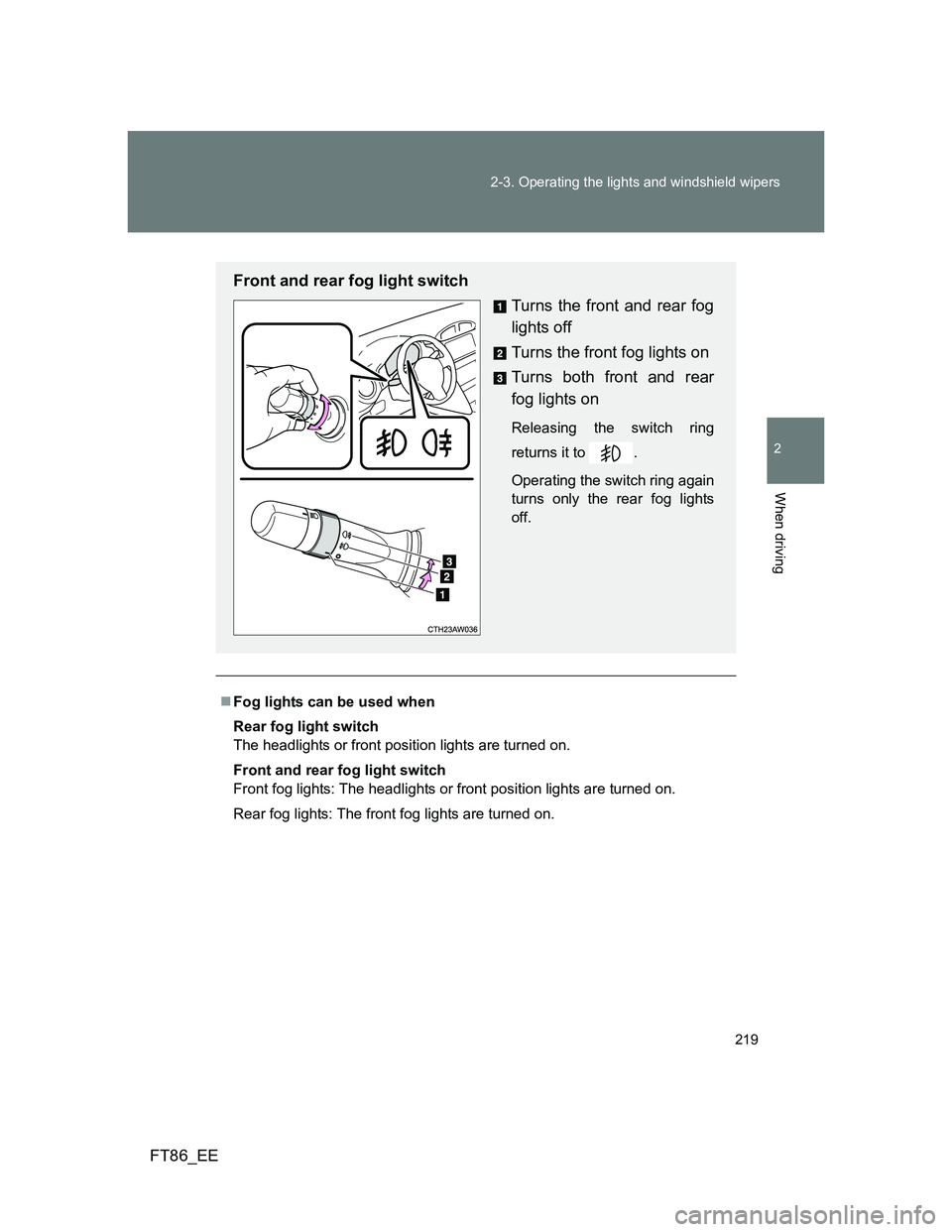
219 2-3. Operating the lights and windshield wipers
2
When driving
FT86_EE
Fog lights can be used when
Rear fog light switch
The headlights or front position lights are turned on.
Front and rear fog light switch
Front fog lights: The headlights or front position lights are turned on.
Rear fog lights: The front fog lights are turned on.
Front and rear fog light switch
Turns the front and rear fog
lights off
Turns the front fog lights on
Turns both front and rear
fog lights on
Releasing the switch ring
returns it to .
Operating the switch ring again
turns only the rear fog lights
off.
Page 221 of 452
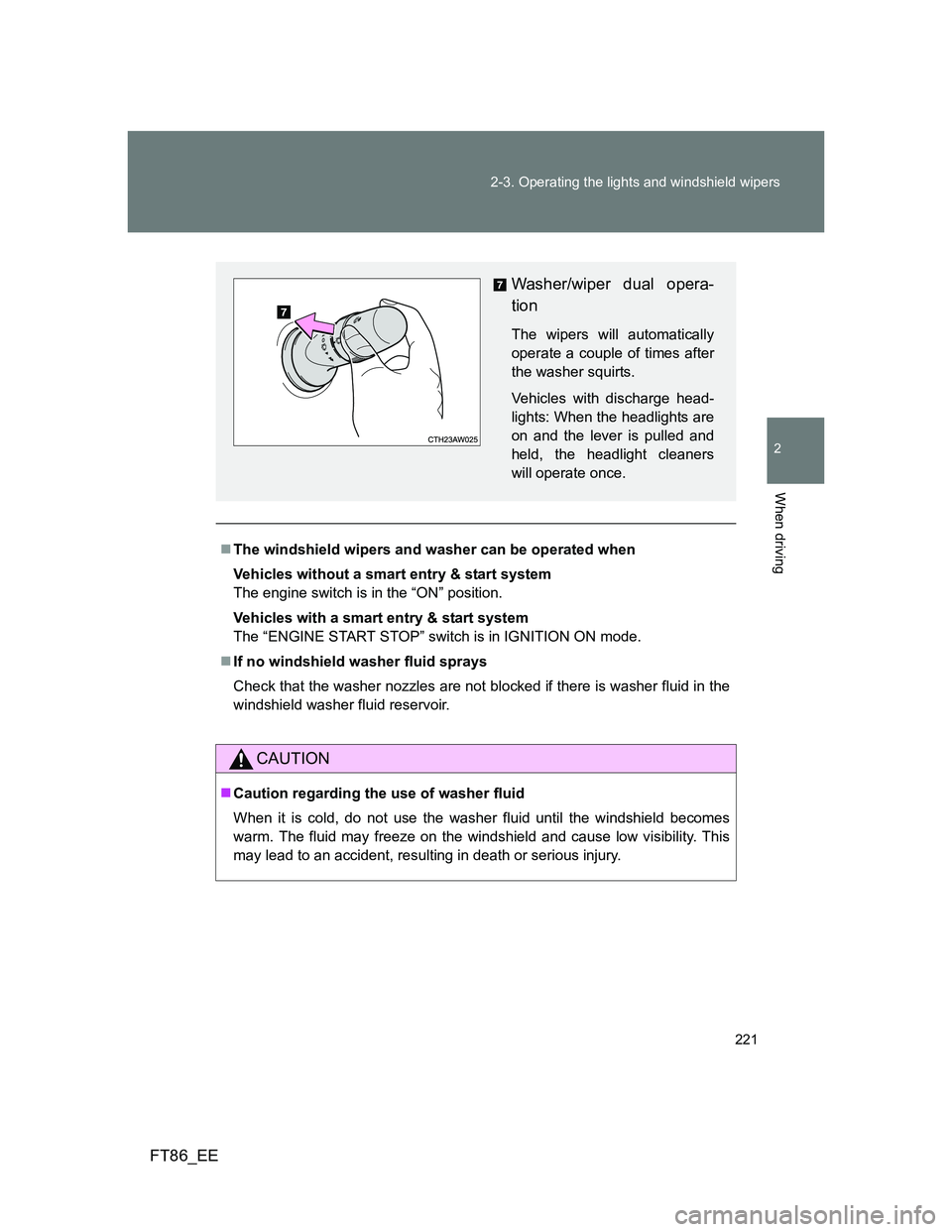
221 2-3. Operating the lights and windshield wipers
2
When driving
FT86_EE
The windshield wipers and washer can be operated when
Vehicles without a smart entry & start system
The engine switch is in the “ON” position.
Vehicles with a smart entry & start system
The “ENGINE START STOP” switch is in IGNITION ON mode.
If no windshield washer fluid sprays
Check that the washer nozzles are not blocked if there is washer fluid in the
windshield washer fluid reservoir.
CAUTION
Caution regarding the use of washer fluid
When it is cold, do not use the washer fluid until the windshield becomes
warm. The fluid may freeze on the windshield and cause low visibility. This
may lead to an accident, resulting in death or serious injury.
Washer/wiper dual opera-
tion
The wipers will automatically
operate a couple of times after
the washer squirts.
Vehicles with discharge head-
lights: When the headlights are
on and the lever is pulled and
held, the headlight cleaners
will operate once.
Page 338 of 452
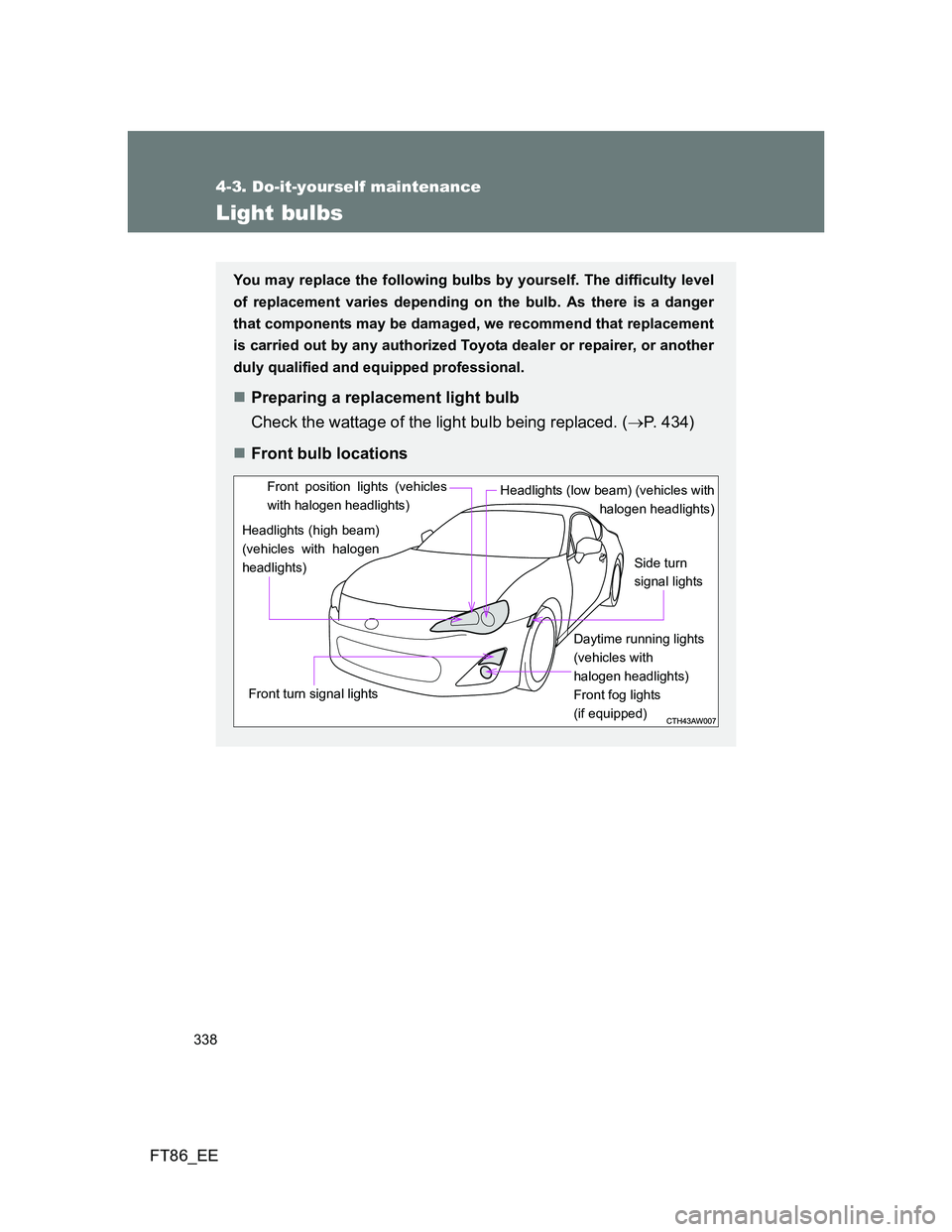
338
4-3. Do-it-yourself maintenance
FT86_EE
Light bulbs
You may replace the following bulbs by yourself. The difficulty level
of replacement varies depending on the bulb. As there is a danger
that components may be damaged, we recommend that replacement
is carried out by any authorized Toyota dealer or repairer, or another
duly qualified and equipped professional.
Preparing a replacement light bulb
Check the wattage of the light bulb being replaced. (P. 434)
Front bulb locations
Headlights (high beam)
(vehicles with halogen
headlights)
Headlights (low beam) (vehicles with
halogen headlights)
Side turn
signal lights
Front turn signal lightsFront position lights (vehicles
with halogen headlights)
Daytime running lights
(vehicles with
halogen headlights)
Front fog lights
(if equipped)
Page 342 of 452
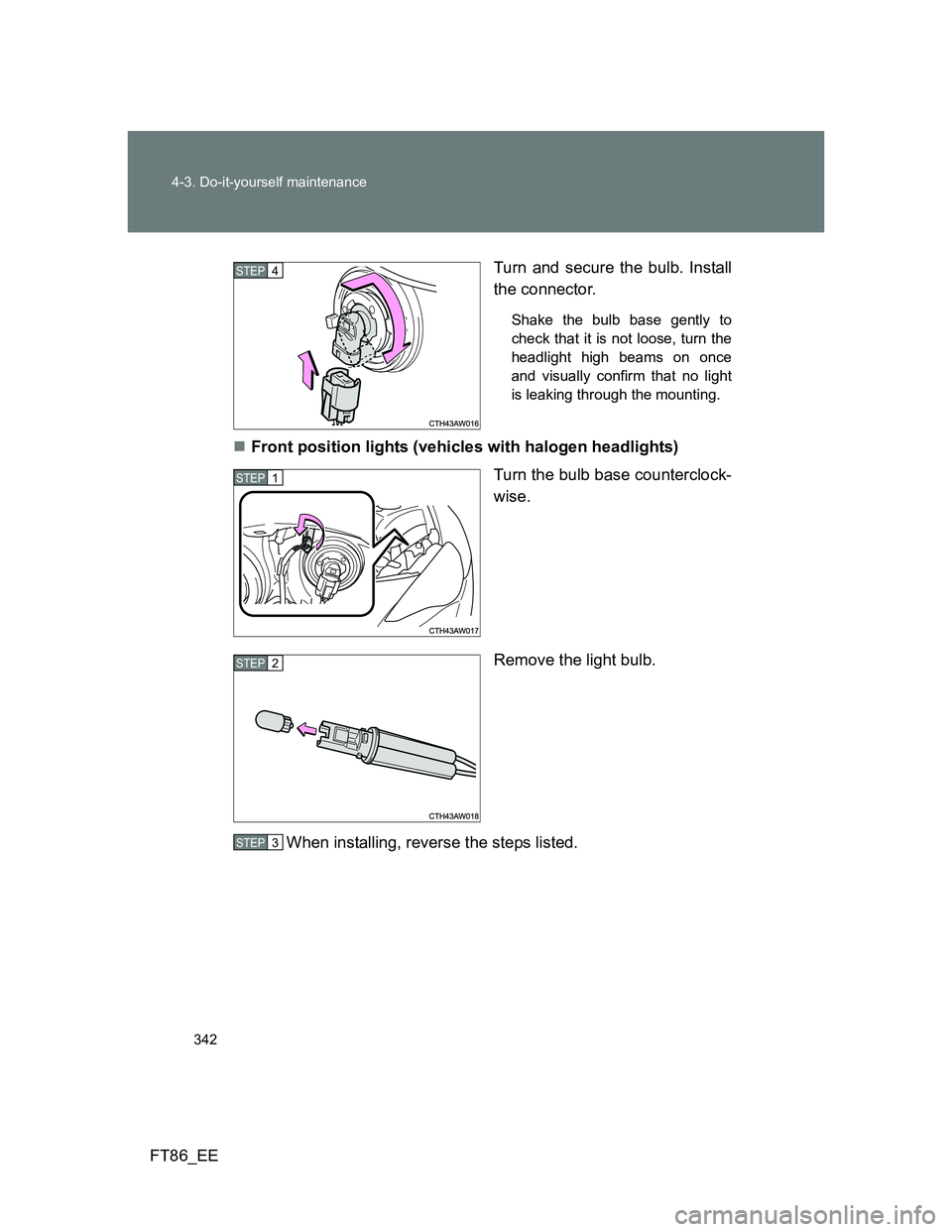
342 4-3. Do-it-yourself maintenance
FT86_EETurn and secure the bulb. Install
the connector.
Shake the bulb base gently to
check that it is not loose, turn the
headlight high beams on once
and visually confirm that no light
is leaking through the mounting.
Front position lights (vehicles with halogen headlights)
Turn the bulb base counterclock-
wise.
Remove the light bulb.
When installing, reverse the steps listed.
STEP 4
STEP 1
STEP 2
STEP 3
Page 346 of 452
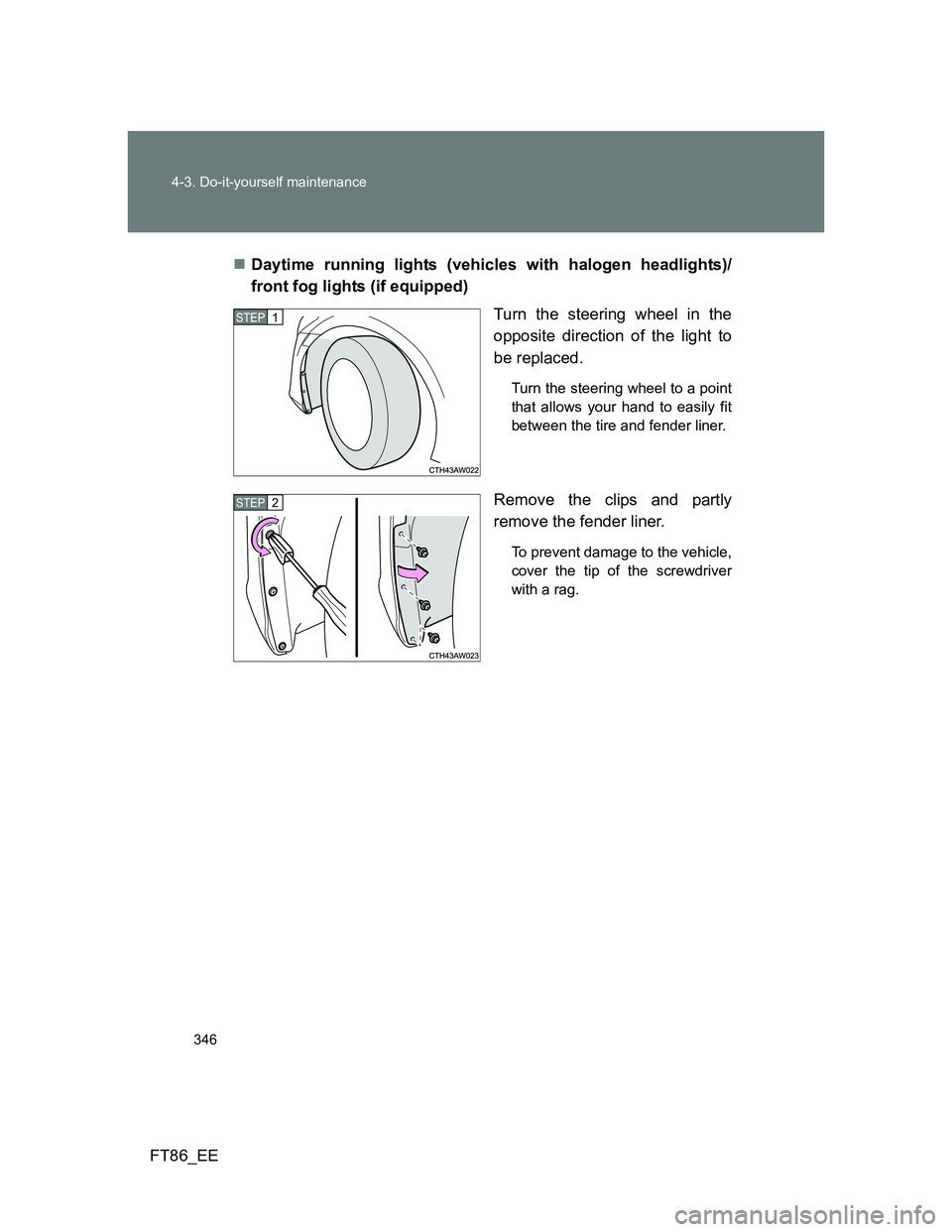
346 4-3. Do-it-yourself maintenance
FT86_EEDaytime running lights (vehicles with halogen headlights)/
front fog lights (if equipped)
Turn the steering wheel in the
opposite direction of the light to
be replaced.
Turn the steering wheel to a point
that allows your hand to easily fit
between the tire and fender liner.
Remove the clips and partly
remove the fender liner.
To prevent damage to the vehicle,
cover the tip of the screwdriver
with a rag.
STEP 1
STEP 2
Page 348 of 452
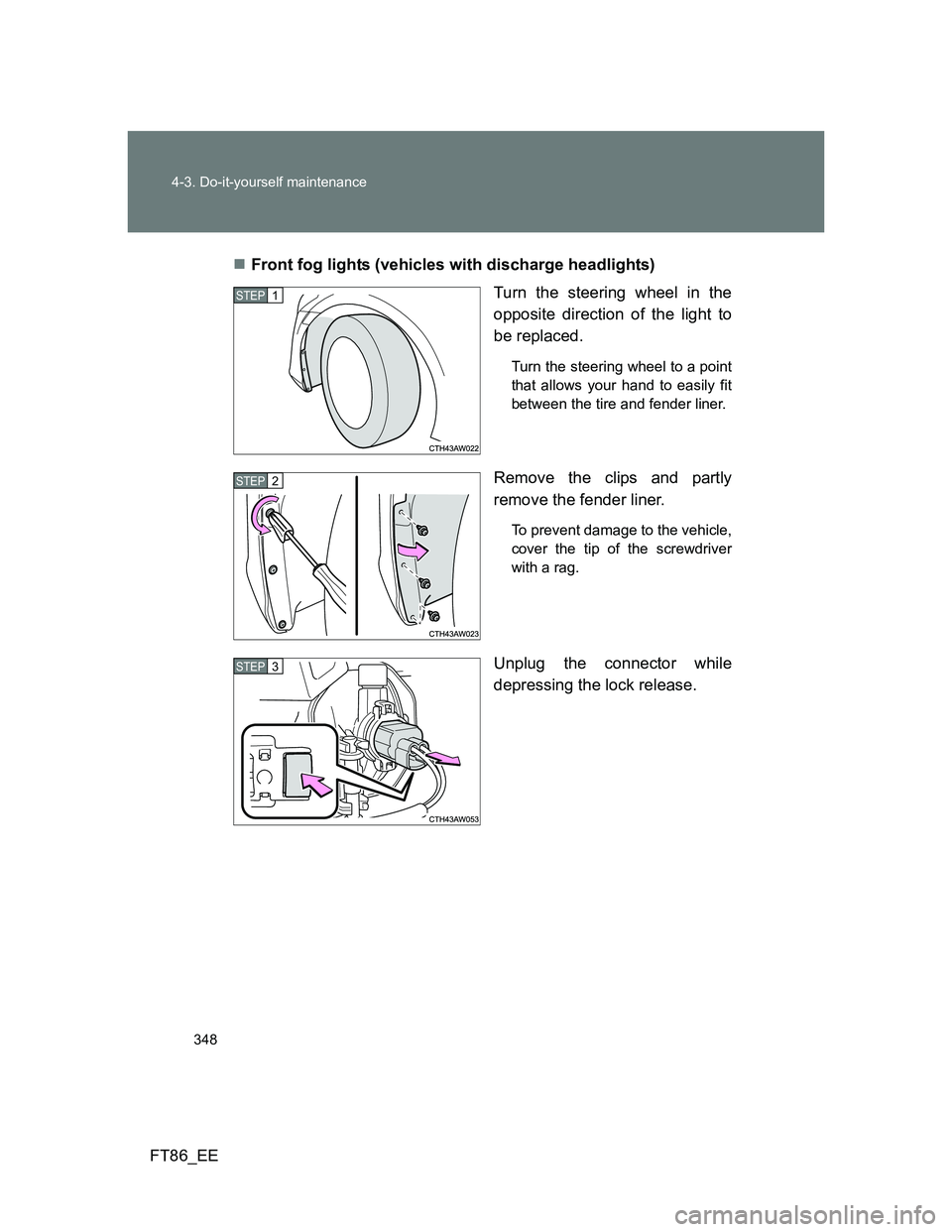
348 4-3. Do-it-yourself maintenance
FT86_EEFront fog lights (vehicles with discharge headlights)
Turn the steering wheel in the
opposite direction of the light to
be replaced.
Turn the steering wheel to a point
that allows your hand to easily fit
between the tire and fender liner.
Remove the clips and partly
remove the fender liner.
To prevent damage to the vehicle,
cover the tip of the screwdriver
with a rag.
Unplug the connector while
depressing the lock release.
STEP 1
STEP 2
STEP 3
Page 353 of 452
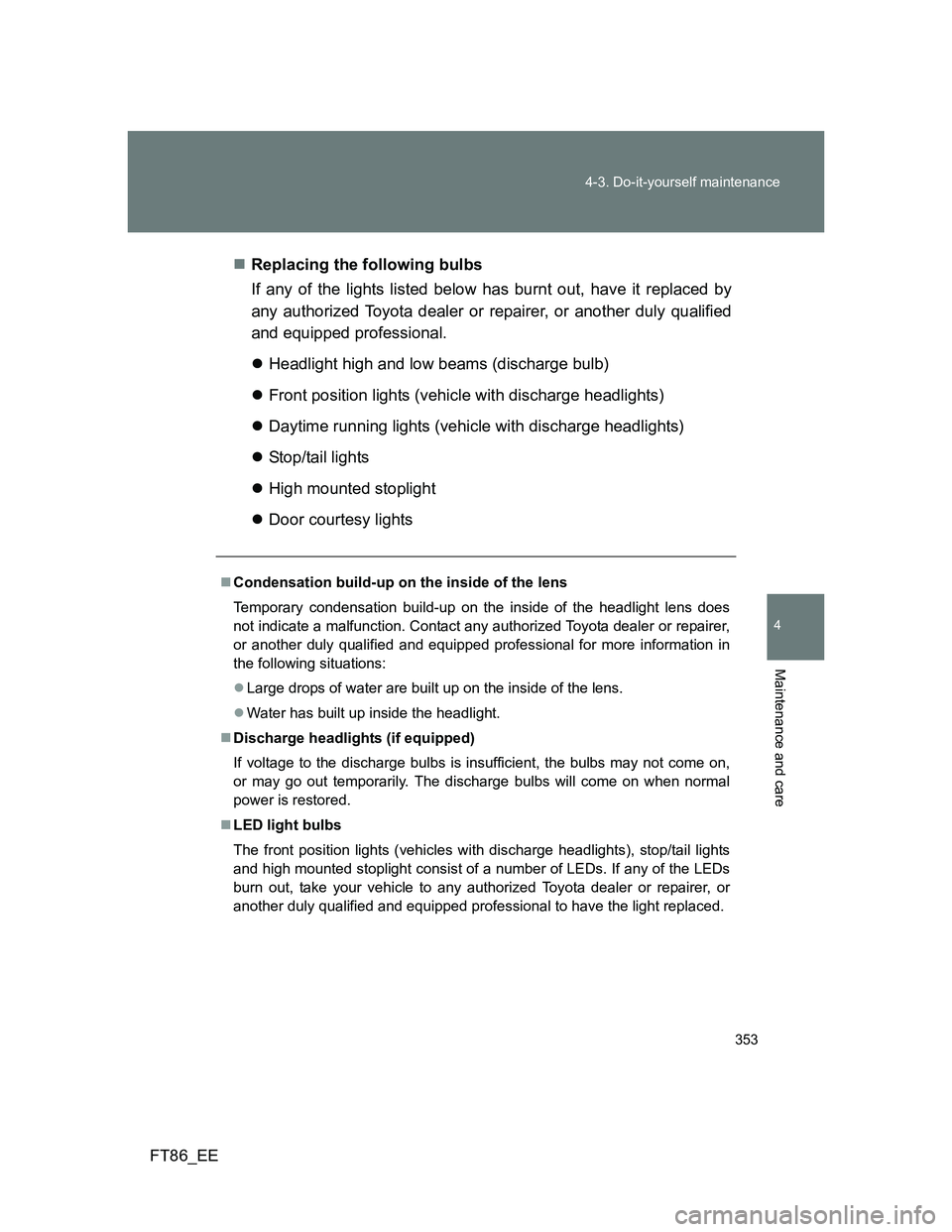
353 4-3. Do-it-yourself maintenance
4
Maintenance and care
FT86_EEReplacing the following bulbs
If any of the lights listed below has burnt out, have it replaced by
any authorized Toyota dealer or repairer, or another duly qualified
and equipped professional.
Headlight high and low beams (discharge bulb)
Front position lights (vehicle with discharge headlights)
Daytime running lights (vehicle with discharge headlights)
Stop/tail lights
High mounted stoplight
Door courtesy lights
Condensation build-up on the inside of the lens
Temporary condensation build-up on the inside of the headlight lens does
not indicate a malfunction. Contact any authorized Toyota dealer or repairer,
or another duly qualified and equipped professional for more information in
the following situations:
Large drops of water are built up on the inside of the lens.
Water has built up inside the headlight.
Discharge headlights (if equipped)
If voltage to the discharge bulbs is insufficient, the bulbs may not come on,
or may go out temporarily. The discharge bulbs will come on when normal
power is restored.
LED light bulbs
The front position lights (vehicles with discharge headlights), stop/tail lights
and high mounted stoplight consist of a number of LEDs. If any of the LEDs
burn out, take your vehicle to any authorized Toyota dealer or repairer, or
another duly qualified and equipped professional to have the light replaced.
Page 354 of 452
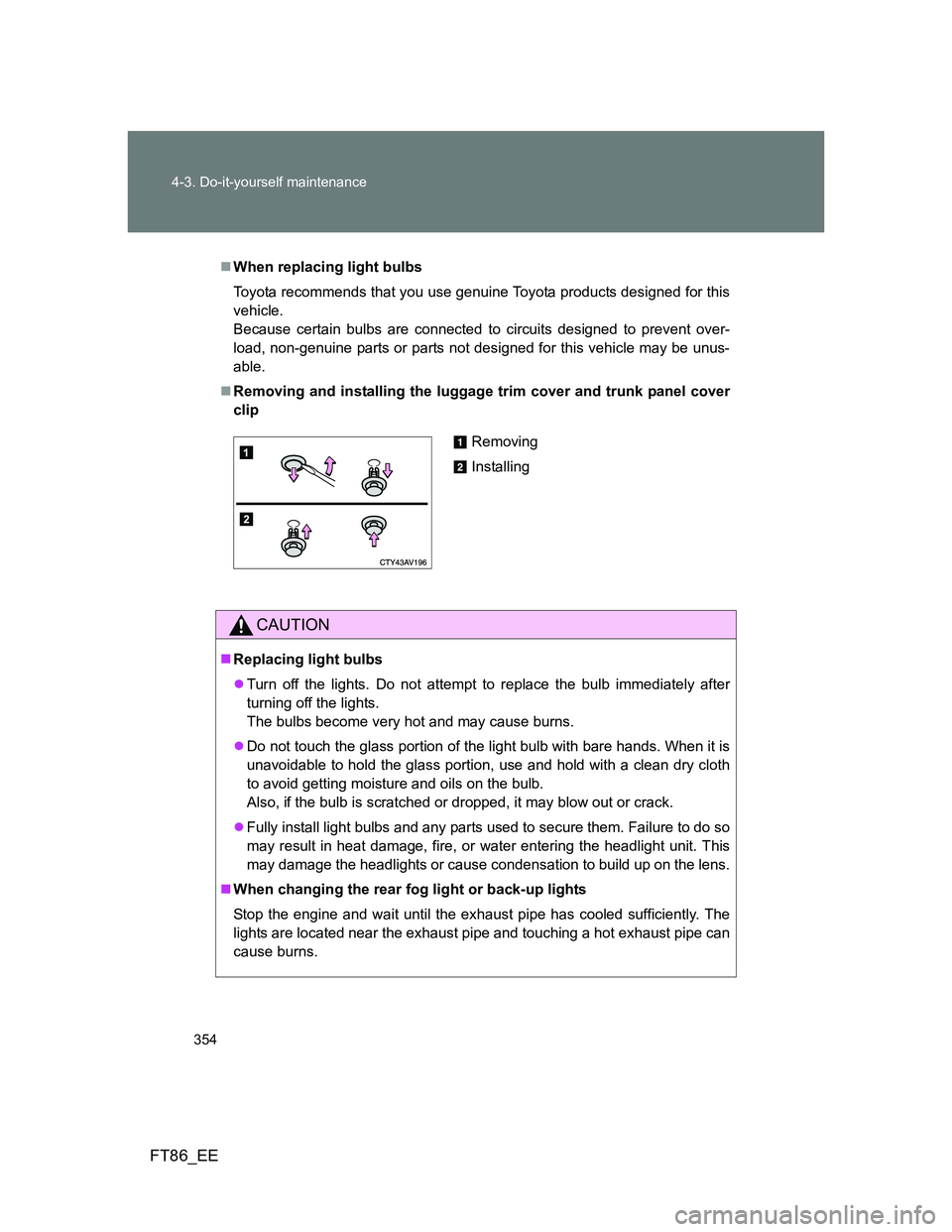
354 4-3. Do-it-yourself maintenance
FT86_EE
When replacing light bulbs
Toyota recommends that you use genuine Toyota products designed for this
vehicle.
Because certain bulbs are connected to circuits designed to prevent over-
load, non-genuine parts or parts not designed for this vehicle may be unus-
able.
Removing and installing the luggage trim cover and trunk panel cover
clip
CAUTION
Replacing light bulbs
Turn off the lights. Do not attempt to replace the bulb immediately after
turning off the lights.
The bulbs become very hot and may cause burns.
Do not touch the glass portion of the light bulb with bare hands. When it is
unavoidable to hold the glass portion, use and hold with a clean dry cloth
to avoid getting moisture and oils on the bulb.
Also, if the bulb is scratched or dropped, it may blow out or crack.
Fully install light bulbs and any parts used to secure them. Failure to do so
may result in heat damage, fire, or water entering the headlight unit. This
may damage the headlights or cause condensation to build up on the lens.
When changing the rear fog light or back-up lights
Stop the engine and wait until the exhaust pipe has cooled sufficiently. The
lights are located near the exhaust pipe and touching a hot exhaust pipe can
cause burns.
Removing
Installing
Page 355 of 452
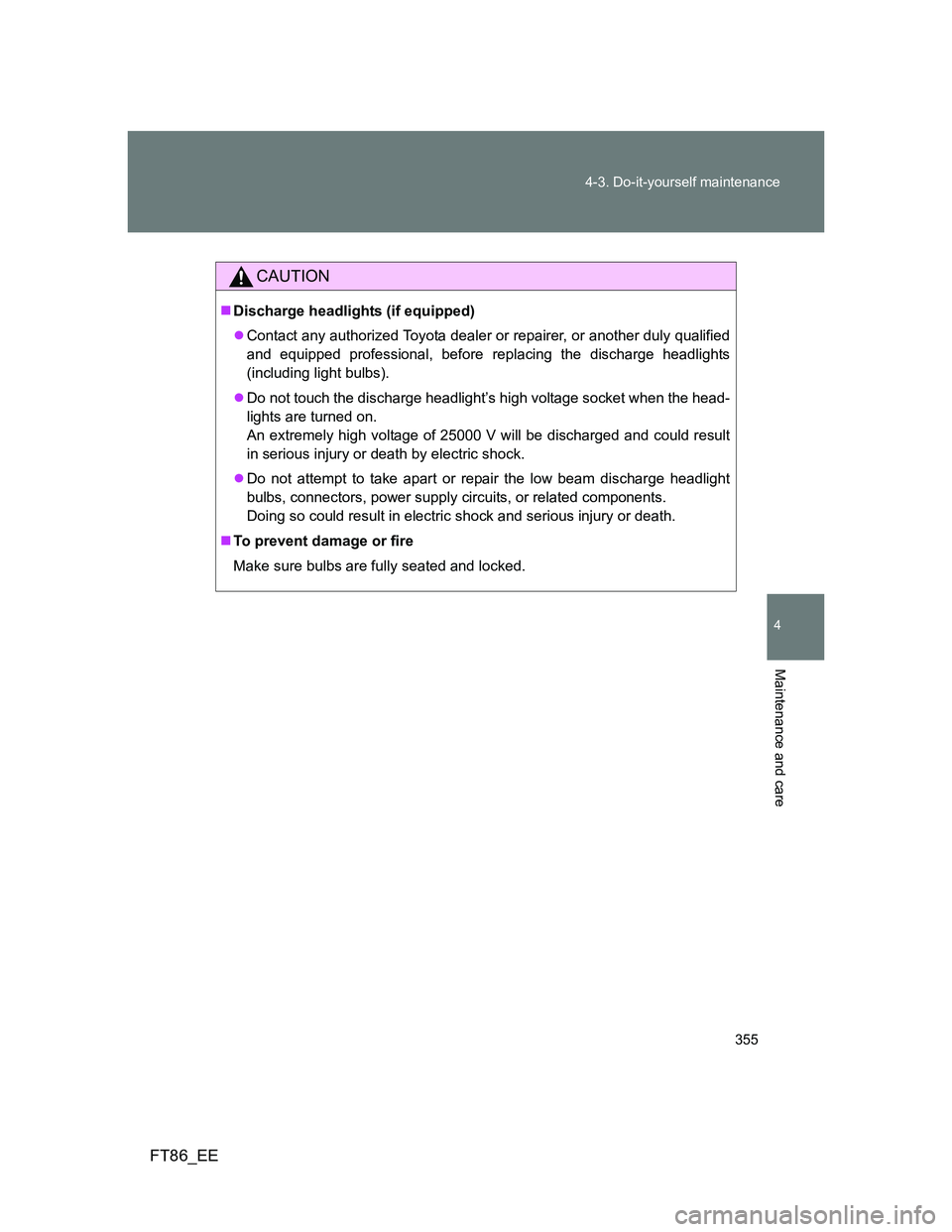
355 4-3. Do-it-yourself maintenance
4
Maintenance and care
FT86_EE
CAUTION
Discharge headlights (if equipped)
Contact any authorized Toyota dealer or repairer, or another duly qualified
and equipped professional, before replacing the discharge headlights
(including light bulbs).
Do not touch the discharge headlight’s high voltage socket when the head-
lights are turned on.
An extremely high voltage of 25000 V will be discharged and could result
in serious injury or death by electric shock.
Do not attempt to take apart or repair the low beam discharge headlight
bulbs, connectors, power supply circuits, or related components.
Doing so could result in electric shock and serious injury or death.
To prevent damage or fire
Make sure bulbs are fully seated and locked.
Page 400 of 452
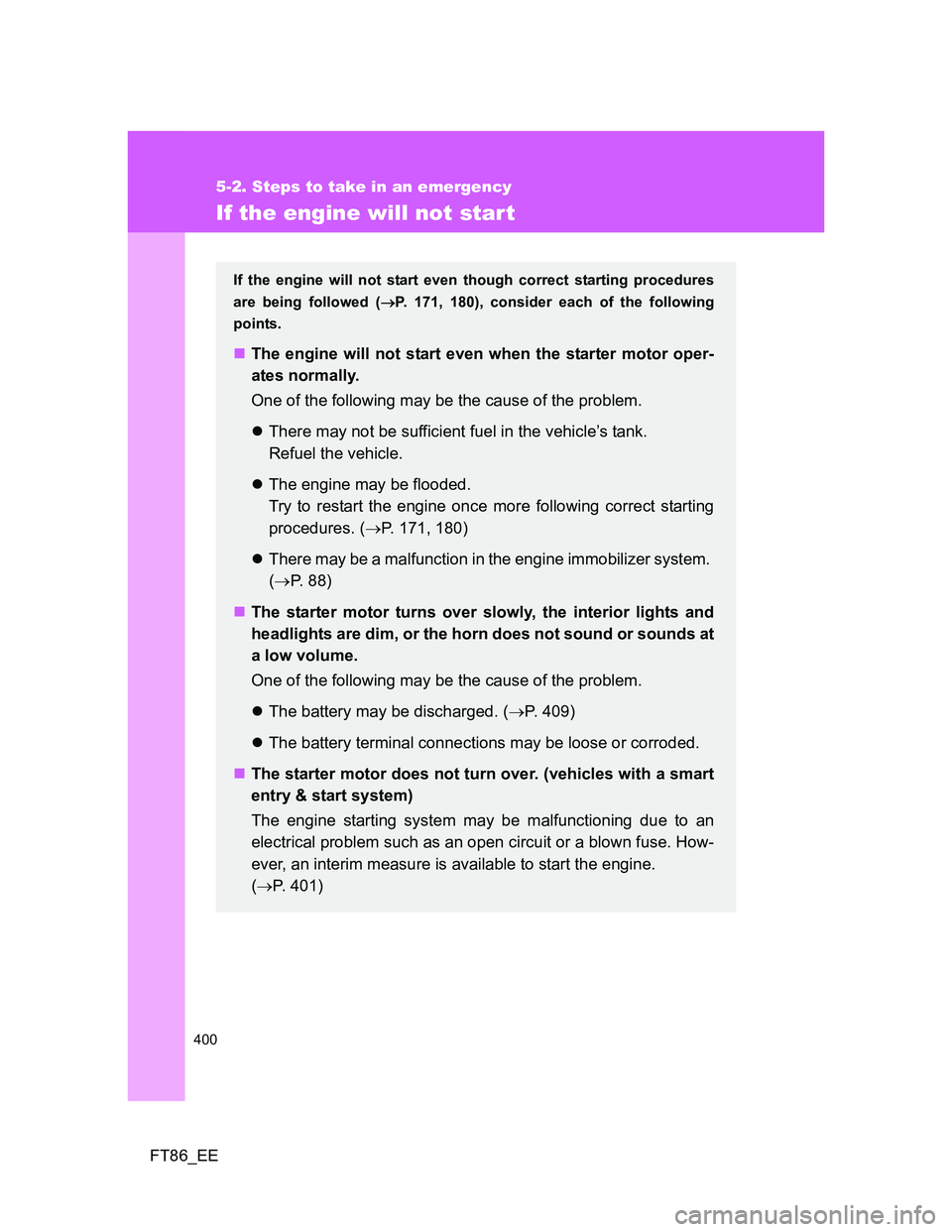
400
5-2. Steps to take in an emergency
FT86_EE
If the engine will not start
If the engine will not start even though correct starting procedures
are being followed (P. 171, 180), consider each of the following
points.
The engine will not start even when the starter motor oper-
ates normally.
One of the following may be the cause of the problem.
There may not be sufficient fuel in the vehicle’s tank.
Refuel the vehicle.
The engine may be flooded.
Try to restart the engine once more following correct starting
procedures. (P. 171, 180)
There may be a malfunction in the engine immobilizer system.
(P. 8 8 )
The starter motor turns over slowly, the interior lights and
headlights are dim, or the horn does not sound or sounds at
a low volume.
One of the following may be the cause of the problem.
The battery may be discharged. (P. 409)
The battery terminal connections may be loose or corroded.
The starter motor does not turn over. (vehicles with a smart
entry & start system)
The engine starting system may be malfunctioning due to an
electrical problem such as an open circuit or a blown fuse. How-
ever, an interim measure is available to start the engine.
(P. 401)